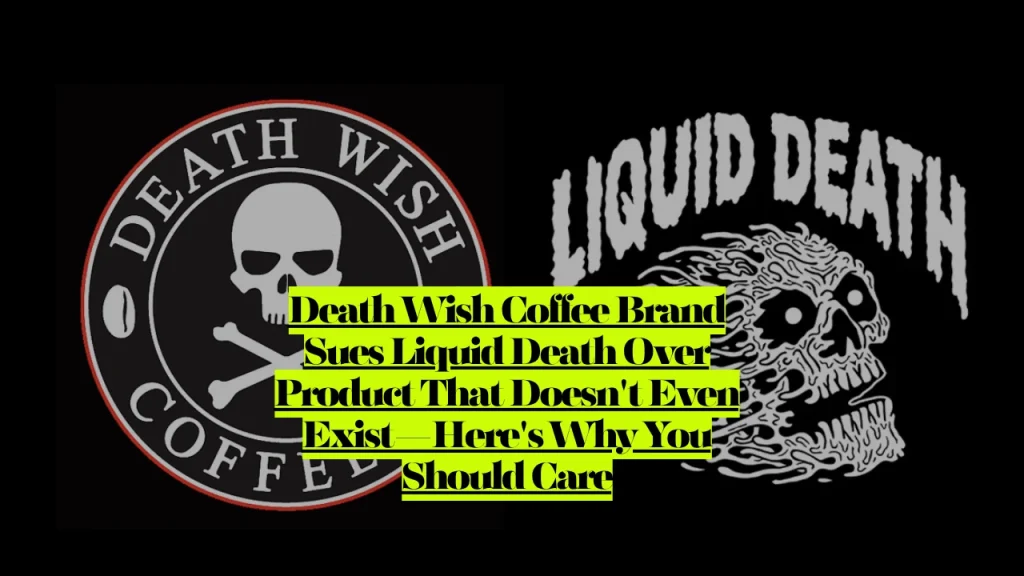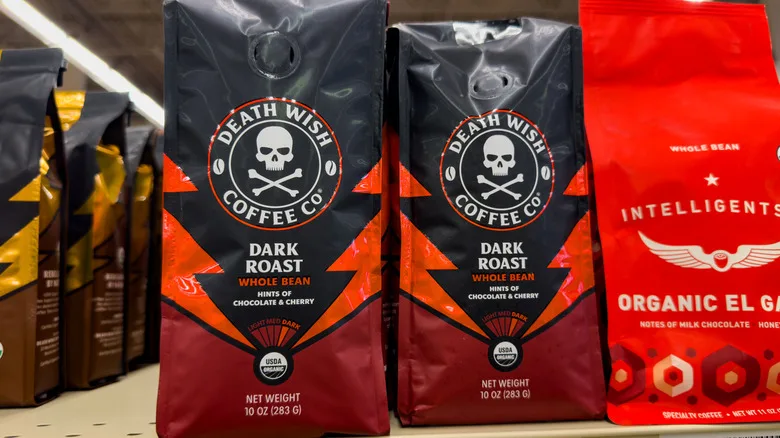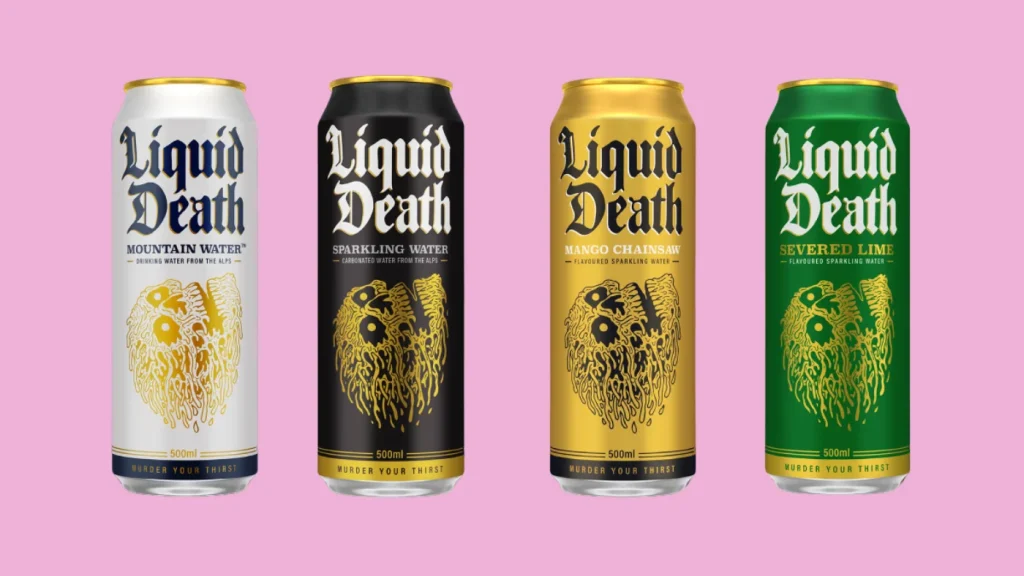Death Wish Coffee Brand Sues Liquid Death Over Product That Doesn’t Even Exist—Here’s Why You Should Care
Death Wish Coffee just filed a federal lawsuit demanding Liquid Death abandon its coffee plans—but Liquid Death says they never planned to make coffee in the first place. This bizarre Liquid Death lawsuit, filed October 7, 2025, could reshape how brands use words, symbols, and even concepts in their marketing. And the drama playing out on social media is just as entertaining as the courtroom battle.
The $1.4 Billion Water Company vs. The “World’s Strongest Coffee”
Death Wish Coffee has filed a federal lawsuit against Liquid Death, accusing the $1.4 billion-valued company of trademark infringement over plans to launch coffee and coffee-flavored beverages. The complaint centers on trademark applications Liquid Death filed for products including “Liquid Death Deathuccino.”
Here’s the twist: Liquid Death wrote on Instagram and X that they have “no real plans to actually launch a coffee” and suggested Death Wish executives are “amped up on too much caffeine to be this paranoid.”
What Death Wish is claiming:
- Liquid Death filed trademark applications for coffee products in May 2025
- Products like “Deathuccino” would confuse consumers
- Both brands use “death-themed” branding and edgy marketing
- Liquid Death plans to launch coffee around January 2026
What Liquid Death is saying:
- They have no actual plans to launch coffee
- No single company can own the word “DEATH”
- Death Wish is being paranoid
- Maybe their CEO should try Liquid Death’s lower-caffeine energy drink instead
Welcome to the most passive-aggressive trademark lawsuit in beverage history.
Can You Actually Sue Over A Product That Doesn’t Exist?
Yes—and that’s exactly what makes this case fascinating.
Death Wish claims that court intervention is necessary now in light of the upcoming launch of Liquid Death coffee products, with trademark applications that include a sworn assertion of a bona fide intent to use the marks as evidence.
How trademark law works:
When you file a trademark application, you must swear you have a “bona fide intent to use” the mark in commerce. That legal declaration becomes evidence that you actually plan to sell the product.
Death Wish’s legal argument: “You filed trademark applications swearing you’d use these marks. That’s proof you’re launching coffee. We’re stopping you before it happens.”
Liquid Death’s response: “We changed our minds. Sue us. Oh wait, you already did.”
The legal chess game:
- Filing a trademark = declaring intent to use it
- Courts can issue injunctions based on planned future harm
- You don’t have to wait until damage occurs to sue
- But if there’s no actual plan, is there actual harm?

The “Death” Branding Battle: Who Owns Mortality?
This isn’t just about coffee. It’s about whether one company can monopolize an entire concept in marketing.
Death Wish, founded in 2012 and based in New York, argues that Liquid Death’s proposed coffee products would confuse consumers and dilute its brand identity, highlighting the “nearly identical aesthetic” shared by the two brands.
Both brands feature:
- Skull imagery and dark, edgy designs
- The word “DEATH” prominently in their names
- Rebellious, punk rock marketing aesthetics
- Tall cans with bold graphics
- Target audience: young, alternative consumers
Liquid Death argued that “we don’t believe any one company can legally own the word DEATH regardless of how it’s used” and pointed out that Death Wish Inc., an iconic hardcore record label, has existed for over 25 years—longer than Death Wish Coffee.
The trademark question: Can Death Wish Coffee claim exclusive rights to “death-themed” marketing in the beverage space?
The Timeline: From Twitter Banter to Federal Court
This feud didn’t start in 2025. These two brands have been circling each other for years.
2022: The Twitter Roast
Death Wish called out Liquid Death on Twitter, asking “How does it feel to be the world’s weakest coffee?” Liquid Death replied, “We’re actually water, not coffee. And without water, you are not coffee either. You’d just be Death Wish Bean Bags.”
Back then, it was just playful rivalry between two edgy brands. They weren’t competing—one sold coffee, the other sold water.
May 2025: Liquid Death Files Trademarks
Liquid Death filed applications with the USPTO for “LIQUID DEATH” and “LIQUID DEATH DEATHUCCINO” covering coffee and coffee-flavored beverages.
July 29, 2025: Death Wish Sends Warning
Death Wish’s counsel sent a detailed letter to Liquid Death’s legal team outlining Death Wish’s trademark rights and objecting to Liquid Death’s plans to enter the coffee market.
August 5, 2025: Liquid Death Stalls
Liquid Death’s counsel replied stating that the company would not provide a substantive response until September 5, but assured Death Wish that no coffee products would launch in the meantime.
September 5, 2025: The Point of No Return
When September 5 arrived, Liquid Death responded with a letter confirming its intent to move forward with the coffee launch.
October 7, 2025: Lawsuit Filed
Death Wish Coffee sued Liquid Death in the US District Court for the Central District of California, arguing the canned-water company’s planned move into coffee-based products will confuse consumers and infringe trademarks.
October 9, 2025: The Social Media Clapback
Liquid Death posts on Instagram denying coffee plans and roasting Death Wish’s CEO.

The Legal Arguments: Does Death Wish Have A Case?
Legal experts are split on whether this lawsuit has merit.
The test for trademark infringement is straightforward: Would the average consumer believe Liquid Death Coffee and Death Wish Coffee come from the same manufacturer?
Death Wish’s strongest arguments:
Visual similarity: Both brands use dark, skull-based aesthetics on tall cans. If these two products appeared side by side on a grocery store shelf, both in tall cans, both with dark, edgy branding, it’s not hard to imagine at least some consumers assuming they were made by the same company.
Market overlap: Both target young, alternative consumers who appreciate rebellious branding.
Retail channels: Death Wish contends that similarities could lead to consumer confusion, particularly as both brands may appear on retail shelves.
Product category: Both would be selling coffee products in similar formats.
Liquid Death’s strongest defenses:
No actual product: You can’t confuse consumers with a product that doesn’t exist.
Generic term: “Death” is a common word that appears in countless brand names across industries.
Different core products: Consumers know Death Wish for coffee and Liquid Death for water—no confusion historically.
Trademark coexistence: Many brands share similar words or themes without causing confusion.
What Death Wish Actually Wants From The Court
Death Wish is asking the court to issue both preliminary and permanent injunctions blocking the launch of Liquid Death’s coffee products. It’s also seeking punitive damages and attorneys’ fees.
Translation:
- Stop Liquid Death from ever making coffee
- Force them to abandon their trademark applications
- Pay Death Wish’s legal bills
- Pay additional money as punishment
The lawsuit also demands that Liquid Death be barred from using any “DEATH-formative” marks for coffee or coffee-related products. That’s broad language that could prevent Liquid Death from ever entering the coffee space under any variation of their brand name.
The Pattern: Liquid Death’s Product Launch Strategy
Death Wish’s narrative is tailored to Liquid Death’s annual product lineup reset, cataloguing Liquid Death’s pattern with sodas (trademark applications filed July 2024, launch January 2025) and energy drinks (trademark filings June 2025, launch announced for January 2026).
Death Wish’s theory: Liquid Death follows a predictable pattern:
- File trademarks mid-year
- Launch products in January
- Deny plans while preparing launch
- Surprise the market with new product category
The evidence Death Wish cites:
- Sodas: Filed July 2024 → Launched January 2025
- Energy drinks: Filed June 2025 → Launch announced January 2026
- Coffee: Filed May 2025 → Predicted launch January 2026
Against this background, Death Wish maintains that Liquid Death’s May 2025 trademark filings for coffee-related products signal a January 2026 coffee drop.
But Liquid Death insists this time is different—they’re not launching coffee at all.
The Social Media War: Memes, Trolling, and Brand Warfare
While lawyers battle in court, fans are fighting on Instagram.
Liquid Death took the opportunity in their response to promote their new energy drink (coming in January) that has zero sugar, 5 calories, essential vitamins, and a sane level of caffeine (100mg).
The water brand didn’t just defend itself—it used the lawsuit as marketing, suggesting Death Wish’s CEO Steve Gardiner is “too caffeinated to be this paranoid” and should try their calmer energy drink instead.
Liquid Death fans have flooded Death Wish’s Instagram, poking fun at the company with Liquid Death GIFs and memes. Death Wish has yet to post about the lawsuit.

The brand warfare strategies:
Liquid Death’s approach:
- Turn the lawsuit into free publicity
- Mock the opposition while promoting products
- Engage fans to attack competitor’s social media
- Position themselves as the cool underdog
Death Wish’s silence:
- Let the lawsuit speak for itself
- Avoid escalating the online drama
- Maintain professional positioning
- Don’t give Liquid Death more attention
Which strategy wins? That depends on whether you value legal victories or viral marketing.
Death Wish’s History: They’ve Done This Before
This isn’t Death Wish’s first trademark rodeo.
Following a 2023 lawsuit in which Death Wish claimed infringement against a roaster called Death Before Decaf, the Saratoga Springs, New York-based brand has filed a trademark lawsuit against their fellow schtick mongers at Liquid Death.
Death Wish has established a pattern of aggressively defending their trademark against any brand using “death” in connection with beverages.
The takeaway: Death Wish takes their brand protection seriously. They’ve built an entire business around being “the world’s strongest coffee” with death-themed marketing, and they’re not letting anyone encroach on that territory.
What This Means For Other Brands
For any retailer with a specific product release cadence, assume plaintiffs will designate those windows as the operative “moment of harm.”
The Liquid Death lawsuit sets a troubling precedent for brands:
Your trademark applications can be used against you: Even if you don’t launch a product, filing for a trademark creates evidence of intent that competitors can weaponize in court.
Predictable patterns become evidence: If your brand consistently launches products in January, courts might assume your trademark filings indicate a January launch—even if you deny it.
Aesthetic similarity matters more than you think: Having a similar “vibe” to a competitor can create trademark issues even if your actual products differ.
Social media banter can escalate: Playful Twitter exchanges can turn into million-dollar lawsuits when market boundaries shift.
The Bigger Question: Consumer Confusion or Corporate Paranoia?
At the heart of this case is a fundamental question: Would reasonable consumers actually confuse Liquid Death coffee with Death Wish coffee?
Arguments for confusion:
- Both use “death” branding
- Both use skull imagery and dark aesthetics
- Both come in tall cans
- Both target alternative/edgy consumers
- Both might appear on the same retail shelf
Arguments against confusion:
- Consumers know Liquid Death as a water brand
- The brands have coexisted peacefully for years
- “Liquid Death” and “Death Wish” are distinctly different names
- Branding styles, while similar in theme, differ in execution
- No historical evidence of actual consumer confusion
The court will have to decide whether Death Wish is protecting legitimate trademark rights or trying to monopolize an entire aesthetic category.
What Happens Next: The Legal Timeline
Short term:
- Liquid Death will file a response to the complaint
- Death Wish may seek a preliminary injunction
- Court will hold hearings on whether to block any potential launch
- Both sides will engage in discovery (exchanging evidence)
Medium term:
- If Liquid Death truly has no coffee plans, they could abandon the trademarks
- Settlement negotiations may occur behind the scenes
- Death Wish could pursue summary judgment
- Trial date could be set for 2026
Long term:
- Case could settle before trial (most likely outcome)
- Trial could result in verdict for either side
- Ruling could be appealed
- Precedent would affect trademark law for years
Wild card scenario: Liquid Death actually launches coffee just to troll Death Wish, turns the lawsuit into the world’s greatest guerrilla marketing campaign, and wins in the court of public opinion even if they lose in federal court.
Industry Reactions: The Beverage World Watches
The beverage industry is paying close attention to this case.
Why it matters beyond Death Wish and Liquid Death:
If Death Wish wins, it establishes that brands can successfully block competitors from entering adjacent product categories based solely on thematic or aesthetic similarity—even without actual consumer confusion data.
If Liquid Death wins (or the case is dismissed), it confirms that common words and general aesthetic themes can’t be monopolized, and brands have more freedom to expand into new categories.
Other brands with “death” in their names: Death Wish Inc. (the record label), Death Before Decaf (already sued by Death Wish), and others are watching to see how far trademark protection extends.
The Irony Nobody’s Talking About
Liquid Death pointed out that Death Wish Inc., the iconic hardcore record label, has been around for over 25 years, long before the coffee brand.
If Death Wish Coffee believes no one else should use “death” in beverage branding, what about the record label that predates them? The irony of demanding exclusive rights to a word you didn’t originate isn’t lost on observers.
Death Wish Coffee might argue that trademark rights are specific to industry categories—coffee is different from music. But that logic cuts both ways: water is different from coffee too.
Expert Legal Analysis: Who’s Likely To Win?
Legal experts offer mixed predictions:
Factors favoring Death Wish:
- Visual and aesthetic similarity is undeniable
- Trademark applications constitute evidence of intent
- Liquid Death’s shifting explanations weaken credibility
- Prior peaceful coexistence ends once markets overlap
Factors favoring Liquid Death:
- No actual product means no actual confusion
- Common words are harder to trademark exclusively
- Different core product identities
- Potential defense that Death Wish is overreaching
Most likely outcome: Settlement. These cases rarely go to trial. Expect Liquid Death to abandon the coffee trademarks in exchange for Death Wish dropping the suit and covering some legal costs.
What This Says About Modern Brand Strategy
The Liquid Death lawsuit reveals how modern brands operate:
File trademarks defensively: Even if you’re not sure you’ll launch a product, file trademarks to keep options open and block competitors.
Use social media as a weapon: Turn legal disputes into marketing opportunities and fan engagement.
Expand strategically: When entering new categories, evaluate not just legal risks but brand perception and competitive response.
Aesthetic identity is valuable: In crowded markets, unique visual branding can be your most defensible competitive advantage.
Ambiguity is risky: Liquid Death’s “maybe we will, maybe we won’t” approach to coffee created legal vulnerability.
FAQs About The Liquid Death Lawsuit
Q: Is Liquid Death actually launching coffee products?
A: It’s unclear. Liquid Death stated on Instagram that they have “no real plans to actually launch a coffee”, but they filed trademark applications in May 2025 for coffee-related products. When September 5 arrived, Liquid Death responded with a letter confirming its intent to move forward with the coffee launch, directly contradicting their public social media statements.
Q: Can Death Wish Coffee really own the word “death” in beverage branding?
A: Not exactly. Trademark law doesn’t grant absolute ownership of common words. However, Death Wish can claim trademark rights to “death” specifically in the context of coffee and similar beverages, especially if they can prove consumer confusion. The question is how far those rights extend.
Q: What is the “Deathuccino” that’s mentioned in the lawsuit?
A: “Deathuccino” is one of the products mentioned in Liquid Death’s trademark applications for coffee-related beverages. It appears to be a play on “cappuccino” combined with Liquid Death’s brand name. Whether this product will ever actually exist remains unknown.
Q: Why did Death Wish wait until now to sue if they were concerned?
A: Death Wish and Liquid Death have successfully coexisted thus far due to their differing product lines. The lawsuit only became necessary when Liquid Death filed trademarks indicating plans to enter Death Wish’s core market: coffee products. Until then, water and coffee didn’t compete directly.
Q: Could Liquid Death’s social media response hurt them legally?
A: Possibly. Their public statements denying coffee plans while their lawyers previously confirmed intent to move forward could undermine their credibility in court. Judges don’t appreciate parties saying one thing publicly and another thing in legal proceedings.
Q: How much money is at stake in this lawsuit?
A: Death Wish is seeking punitive damages and attorneys’ fees, but no specific dollar amount has been disclosed. The real stakes are strategic: whether Liquid Death can enter the coffee market and whether Death Wish can defend its brand territory.
Q: Has there been actual consumer confusion between these brands?
A: The lawsuit doesn’t cite evidence of actual historical confusion, likely because the brands have sold different products until now. Death Wish’s argument is based on predicted future confusion if Liquid Death launches coffee.
Q: What should other beverage brands learn from this case?
A: Treat trademark applications as discoverable timelines—they don’t just reserve rights, they serve to signal intent. Be cautious about filing trademarks for products you’re unsure about launching, and be consistent in your communications about product plans.
The Verdict (That Hasn’t Been Rendered Yet)
The Liquid Death lawsuit represents a collision of modern brand warfare tactics: aggressive trademark protection meets viral marketing culture. Death Wish is playing by traditional legal rules—defend your territory, prevent confusion, protect your brand equity.
Liquid Death is playing by internet rules—turn everything into content, mock your enemies, engage your fans, and win the publicity battle even if you lose the legal one.
Death Wish alleges that the two companies’ coffee products could be sold side by side, targeting similar consumers and using overlapping marketing and retail channels. That’s a legitimate concern that courts take seriously.
But Liquid Death’s response—essentially “we’re not even making coffee, so chill”—raises the question of whether this lawsuit is necessary or whether Death Wish is being preemptively paranoid.
The truth probably lies somewhere in the middle: Liquid Death was considering coffee, filed trademarks to keep options open, and then backed away when legal pressure mounted. Death Wish, having seen this pattern before, decided to kill the threat before it materialized.
What This Really Means For Consumers
While these two brands battle over the right to use “death” in marketing, consumers are left wondering: who actually benefits from this legal fight?
If Death Wish wins, they protect their market position but confirm they’re willing to sue over aesthetic similarities—not exactly the rebellious brand image they cultivate.
If Liquid Death wins, they gain the right to sell coffee but look like they intentionally provoked a lawsuit for publicity—validating accusations they’re all marketing and no substance.
The real winner? The lawyers billing hundreds of dollars per hour to argue about whether one company can own the concept of death-themed beverage marketing.
The real loser? Anyone hoping for actual competition and innovation in the beverage industry instead of brand warfare over who gets to put skulls on cans.
Conclusion: Death, Taxes, and Trademark Litigation
The Liquid Death lawsuit is absurd, significant, and completely predictable all at once. It’s absurd because it involves suing over a product that allegedly doesn’t exist. It’s significant because it could reshape how brands protect aesthetic identities. It’s predictable because, well, this is how modern capitalism works.
Two private equity funded CPG beverage brands are having the legal version of a slap fight over the ownership (and implied marketability therein) of Death itself.
Whether you side with Death Wish Coffee’s right to protect their brand or Liquid Death’s argument that no one can own a common word, one thing is clear: this lawsuit has already accomplished what both brands desperately want—attention.
Death Wish gets to look like the serious, legally sophisticated brand protecting its intellectual property. Liquid Death gets to be the scrappy underdog mocking the establishment and generating viral content.
And we get to watch two edgy beverage companies fight over who has the right to remind us of our mortality while we’re buying a drink.
The case continues. The memes multiply. The lawyers get paid. And somewhere, someone just wants to know: is this coffee going to launch or not?
Legal Disclaimer: This article is for informational and educational purposes only and does not constitute legal advice. The information presented is based on publicly available court documents, trademark filings, and media reports current as of October 2025. Trademark law is complex and case-specific. This article does not predict legal outcomes or provide recommendations regarding brand strategy. For specific legal guidance regarding trademark issues, consult with a qualified intellectual property attorney licensed in your jurisdiction.
About the Author

Sarah Klein, JD, is a licensed attorney and legal content strategist with over 12 years of experience across civil, criminal, family, and regulatory law. At All About Lawyer, she covers a wide range of legal topics — from high-profile lawsuits and courtroom stories to state traffic laws and everyday legal questions — all with a focus on accuracy, clarity, and public understanding.
Her writing blends real legal insight with plain-English explanations, helping readers stay informed and legally aware.
Read more about Sarah
